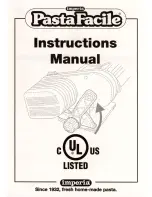
LM3510 Print & Apply Label Applicator
USER’S MANUAL
Page 43
Made in the U.S.A.
© 2019 LABELMILL
11/01/2019 Model LM3510
KEY DEFINITIONS
•
ASYNCHRONOUS OPERATION – The term “ASYNCHRONOUS OPERATION” is used because the speed
of the printer applicator motor (label speed) does not necessarily match the speed of the product conveyor. In
other words their speed is set independently of one another and has NO interrelation. The 3510 can only be
configured in asynchronous operation.
•
SYNCHRONOUS OPERATION - The term “SYNCHRONOUS OPERATION” is used because the speed of
the applicator motor (label speed) is matched to the speed of the product conveyor. In order to accomplish
this, an encoder is used to monitor the speed and distance the product conveyor travels. In order for this
feature to function the “CONVEYOR LOCK” mode must be turned on. In synchronous operation, the
applicator motor is ELECTRONICALLY GEARED to the product conveyor.
The 3510 can NOT be
configured in synchronous operation.
•
START COMPENSATION – Start compensation compensates for the reaction time of the Label Mill control
and start signal from the product switch. The purpose of start compensation is to maintain label placement on
a product that is traveling at different speeds. An example of this is a conveyor that accelerates on start up
and decelerates to a stop. At high speeds an uncompensated system would apply a label too late and the
label would be placed too far back on the product. Linear interpolation is used to correct this problem. The
start compensation corrects this error by adding an offset distance at LOW speeds, since it is not possible to
apply any correction at high speed.
Note: Start compensation ONLY effects label placement on product.
•
ELECTRONIC GEARING – Electronic gearing is a function of the product encoder and the Label Mill control.
This is used to match the speed of the applicator to the product conveyor. Electronic gearing is similar to
mechanical gearing in that there is a gear ratio and the change of speed of one affects the speed of the other.
This feature is part of the Synchronous feed mode. In order for this to operate properly, the correct number of
lines per inch of product travel must be entered into the ENC LINES/INCH in menu #6.
•
ENCODER – AN ENCODER is a device that is used to monitor the speed of an external device like a product
conveyor. The reason this speed is monitored is to match the speed of the label applicator to the product
speed. An encoder uses “LINES or COUNTS” per revolution in order to track speed and distance. Note that
lines per revolution are also referred to as counts per revolution. These counts are feed into the LABEL MILL
control to be processed for the different features that require this feedback.
•
ENCODER OVERRIDE – This feature is used in conjunction with ELECTRONIC GEARING. This feature is
used to fine-tune the ratio of the applicator to the product conveyor.
•
TRIGGER DIST – TRIGGER DISTANCE is used in conjunction with the encoder feature. Trigger distance is
similar to product delay in that it is used to electronically move the placement of the label on the product.
When the encoder feature is used, the product delay feature is rendered inactive. Trigger distance will move
the label placement in inches (00.00).
•
PRODUCT DELAY is NOT used in conjunction with the encoder feature. Product delay is similar to trigger
distance in that it is used to electronically move the placement of the label on the product. Product delay will
move the label placement in time (00.000) seconds. Because the product delay feature utilizes time, the
speed of the product MUST remain constant. A product traveling at a higher velocity will travel further in a
given time, thus effecting the placement of the label.
3-16
















































